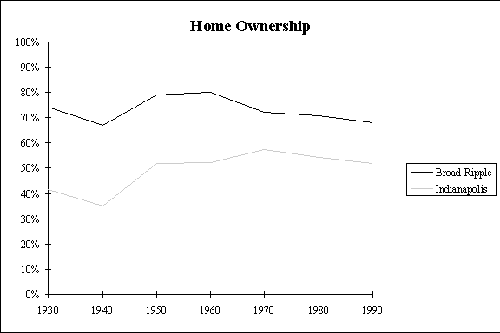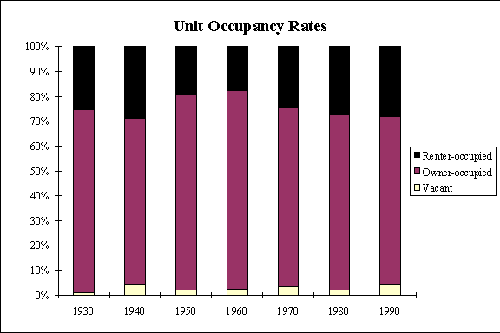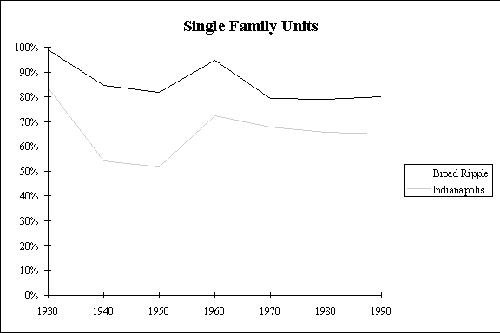From 1996 to 2002, we used a community-academic collaboration to explore and understand the ways in which religion and community have shaped each other in Greater Indianapolis. In the process, we compiled the largest collection of meaningful religious data ever gathered on one American city. Working through community-based partnerships, we cultivated public inquiry and civic conversation about the role of religion in this exemplar metropolitan community. The seven-year project was funded by grants from Lilly Endowment, Inc.,
Part of the project included development of neighborhood narrative histories and timelines. The neighborhood information captures highlights through 1996.
Broad Ripple is a neighborhood located on the northeast side of Indianapolis, bounded by the White River, Keystone Avenue, Kessler Boulevard, and Meridian Street.
Broad Ripple is located on the northeast side of Indianapolis and bounded by the White River, Keystone Avenue, Kessler Boulevard, and Meridian Street. Since its founding as a village in the early 19th century, canals and railroads, streetcars and interurbans, and finally the automobile have influenced the development of the community. Each form of transportation contributed unique elements to the emergence of this settlement, both as a separate village and later as part of the modern city of Indianapolis, thereby providing an interesting study in how transportation can shape and influence community development over time.
The history of this small community along the White River conceivably can be traced to 1816, when Indiana achieved statehood. Delegates to the first constitutional convention had included a section within the constitution that the permanent capital should be located in the central part of the state. In June 1820 ten commissioners appointed by the Indiana General Assembly assembled at the cabin of fur-trader/landowner/entrepreneur William Conner in present-day Hamilton County and traveled into the area where Fall Creek meets the White River, seven miles southwest of present day Broad Ripple. Commissioner John Tipton reported that after the commissioners had signed their recommendations on June 7, 1820, to locate the capital at the confluence of these two waterways, they witnessed several families traveling upriver on flatboats loaded with their household goods. With the site of the new capital finally located, the federal government began selling land in what became Marion County. Among the first buyers in the northern regions of the county were Jacob McKay and John Calip, who acquired 147 acres and began farming their land in what would become the Broad Ripple area. [1]
The state commissioners selected the new site for the state capital because of the White River and the great potential for connecting central Indiana to outside markets. The White River, which meandered through the county, was shallow in spots. One such location was near the land acquired by McKay and Calip. Here, the land was very wide and broad and the river, when low, “rippled” over the stones in the riverbed. Because it was easy to determine the water’s depth at this point, the ripples became a popular river crossing.
To promote the economic development of Indiana, the General Assembly embarked upon a massive program of internal improvements in the 1830s. In 1836 it passed the “Mammoth Internal Improvements Act,” which proposed a statewide network of improved roads, canals, and cleared rivers. One component of the plan, the Central Canal, would link the state’s central region to the Wabash River, running north and west of the capital, and ultimately to the canals in Ohio which would provide links to points further east. The segment of the canal located within Marion County was to begin at the ripple in the riv er and continue south to the center of Indianapolis and beyond. John Burke, involved in the earlier construction of the Wabash and Erie Canal in the north central part of the state, surveyed the area for the canal and began construction of the feeder dam on White River, just north of where the canal and river intersect. Burke hired many Irish immigrants to work on the canal and they resided nearby. [2]
With construction work begun on the Central Canal, the potential for growth appeared promising. In 1836 Jacob Coil moved his family from Virginia, purchased land from the McKays and Calips, and established a ford at the “ripples.” At the same time, John Wray built a home, grocery, and saloon near the location of the dam; Robert Earl opened a general store. On April 20, 1837, Jacob Coil laid out forty-eight lots north of the canal route and called his new community “Broad Ripple.” Four weeks later, on May 17, James A. and Adam R. Nelson platted a 32 lot-community on the south side of the canal and named their town Wellington. Thus began an intense rivalry between the two canal settlements. [3]
On June 27, 1839 local residents celebrated the opening of the canal, but their revelry was shortlived. The State of Indiana went bankrupt due to excessive expenses associated with the many internal improvement projects and bad investments by the state. This halted all construction on the canal, leaving slightly more than eight miles of the canal completed between the villages of Broad Ripple and Wellington and the capital city of Indianapolis to the south. Although this effectively ended any hopes for a canal connector for central Indiana, the existing section of the canal linked the northern part of the county with the capital. In July 1839 Robert Earl advertised canal boat service between Indianapolis and Broad Ripple. [4]
Even though construction had ceased, many residents of the area saw the intersection of the canal and river as a prime location for commercial interests and a focal point for a developing community. By this time, Marion County had been divided into townships with Washington Township organized in 1822. Given their location at the center of the township, both Broad Ripple and Wellington seemed poised for expansion. Within a few short years, the area blossomed. John Burke, who had worked on the canal, opened a saw mill in 1843. Two years later Peter Koontz joined Burke and built a grist mill. That same year a graded township school opened. In 1850 the U.S. Post Office Department established the Broad Ripple post office with William Earl as its first postmaster. Over the next thirty years the post office shifted between the two communities. Finally, in 1884, the U.S. Post Office Department located the office in Wellington but retained the name Broad Ripple. As a result of this action, the two rival communities merged and incorporated as Broad Ripple with some 150 residents. [5]
In the years prior to the merger and incorporation, the two communities attracted a variety of professionals, merchants, businesses, institutions, and organizations, all of which contributed to the residential development of northern Marion County. The area’s first physician, Dr. Harry Kerr, maintained an office from 1850 to 1880. Washington Township constructed a grade school in 1854 near the present-day corner of Broad Ripple and Evanston Avenues in 1854. Local farmers organized a chapter of the Grange in 1873, while the International Order of Odd Fellows opened Broad Ripple Lodge No. 548 in 1877. [6]
Religious activities were present during the formative years of Broad Ripple and Wellington, but permanent church buildings were not evident until at least mid-century. Local histories report that the Reverend James Haven, a Methodist, held a camp meeting in Broad Ripple in 1836 and that several canal workers tried to disrupt that first meeting. It was clear in the ensuing years of community development, however, that there were insufficient numbers of any one faith to support a single denominational church building. In 1851 local residents gathered subscriptions to build the Union Church in Wellington (located on the present site of a fire station at 6330 Guilford). Jacob Coil, son of Broad Ripple’s founder, donated the land for the building. Canal supervisor and local businessman John Burke joined Coil as the church’s first trustees and Henry Coe, a Presbyterian, served as the church’s first minister. Over the years, local Methodists, Presbyterians, and Baptists used the church facility. Madison Hume was an early preacher for the Baptists. The Reverend Frank Hardin served the newly established Methodist class in 1852, which became known as the Broad Ripple Methodist Episcopal Church. [8]
Washington Presbyterian Church organized in 1838, north of White River and present-day Malott Park. Over the years, other churches representing the predominant denominations of the day established congregations elsewhere in Washington Township, though none located near Broad Ripple and Wellington. [9]
While the structures of viable communities were clearly evident in both Broad Ripple and Wellington during their first decades of existence, the communities’ developers did not experience immediate success from their investments. In 1851, after only a few years in operation, the local sawmill was abandoned and torn down. Local historian Berry Sulgrove, writing in his 1884 history of Indianapolis, noted by that time that portions of the original village of Wellington had reverted to farmland. Several floods over the years destroyed local businesses and made it difficult to maintain business in the area. An 1847 flood destroyed Burke’s mill; one in 1875 destroyed the grist mill (one of the oldest standing houses) and a store. Following the failure of its canal projects, the state in 1851 sold the Central Canal to a private company. Over the ensuing years, the canal changed hands several times. In 1867, however, the forerunner of the Indianapolis Water Company purchased the canal as a source of water for the rapidly growing city of Indianapolis. [10]
Although railroads had first appeared in Indianapolis in 1847, it was not until 1883 that the Indianapolis, Delphi, and Chicago Railroad established a line extending through Broad Ripple. With its arrival and eventual connection to Union Station in 1887, the railroad brought new business to the Broad Ripple area. A hotel and several new stores soon opened. In 1887 Kingan Meat Packers, an Ireland-based meat-packing firm with a plant in Indianapolis since 1862, built several ice houses along the river. Local residents harvested the ice from White River and stored it in the large wooden structures. During the summer months, the company transported the ice by rail to its main packing plant on the southwest edge of Indianapolis’s downtown.
Following the arrival of the railroad in Broad Ripple and on the heels of a statewide natural gas boom, local businessmen began drilling gas wells in the Broad Ripple area in 1896. Among them was local physician Dr. Robert C. Light, who formed the Broad Ripple Gas Company. These developers soon met with success and designated their find as the Broad Ripple Oil Field. Production from the local wells topped out in 1898 with 102,987 barrels. Two years later production had dropped to 36,194 barrels. By 1906 most investors had abandoned their wells.
During the heightened business activities of the 1880s and 1890s, the social and institutional life of the community also expanded. Following its incorporation in 1884, Broad Ripple opened its own two-story brick school on the south bank of White River. The school offered all grades, including an advanced program of study. Two years later Broad Ripple High School opened and quickly became a focal point for the community; the Indiana Department of Education commissioned the school in 1895. [11]
Two new churches opened—the Pentecost Church (1898) and the Christian Church (1899). Robert Light helped to organize the Broad Ripple Band in 1900. [12]
In the midst of the community’s growing prosperity, Broad Ripple encountered several disasters which disrupted business and residential life. The train bridge over White River collapsed in 1884, killing several people. That same year, the White River broke through levees constructed after the 1875 flood, leaving the town under water for several days. Another flood swept through town in 1903. The Broad Ripple Hotel burned in 1889, and a gas explosion destroyed several businesses in 1891. Broad Ripple High School, the pride of the community, burned in 1896. During construction of the new school, classes were held in local community buildings; the new school opened in 1897. Kingan’s ice houses burned and were rebuilt in 1902; the company abandoned the facilities in 1917. [13]
Broad Ripple gradually developed as a recreation spot, attracting residents of the surrounding area. As early as the 1860s the Jonas Huffman farm, established in 1822 on 60 acres of land on the east side of White River and owned by Huffman’s son James and partner Charles Dawson, attracted picnickers to the riverbank. With the arrival of the railroad in Broad Ripple in 1883 and its connection to downtown Indianapolis in 1887, people had access to the Broad Ripple community. The transportation boom did not occur, however, until Dr. Light and William Bosson organized the Indianapolis and Broad Ripple Transit Company, which replaced the mule-drawn cars with electrified streetcars in 1894. Ten-cent fares attracted large numbers of people to the banks of White River, where a park had been established since 1890. The streetcar company, renamed the Broad Ripple Traction Company in 1897, continued to provide regular service to Broad Ripple, drawing more people from the city to this community along the river.
In the early 1900s, Indianapolis residents, aided by the availability of the streetcar lines, began coming to the Broad Ripple area as a summer retreat from the city. The Indianapolis Star in July 1911 described the many residents who had built summer homes—ranging from rustic cottages to comfortable homes with electricity and indoor plumbing—and the numerous recreational activities of summer visitors along the banks of White River. By this time, some families had become year-round residents and used the streetcars or their own automobiles to commute to downtown Indianapolis workplaces.
Besides the summer cottages, Broad Ripple supported many recreational opportunities, which attracted day visitors. Boat clubs and steamships offered opportunities to enjoy the river. The small steamship “Sunshine” arrived in Broad Ripple and plied its way along White River in 1897. Other small ships offered music, dancing, and one-day trips on the river. Some encountered serious problems navigating the river, running aground in shallow spots, being damaged by ice, or—as in one peculiar case—sinking because the passengers all ran to one side of the boat to view a pretty girl.
The high point of Broad Ripple’s recreational development, however, was the opening of White City Amusement Park on May 26.1906. The park occupied land previously owned by the Huffman and subsequently Dawson families. It had served as a popular picnic spot, until building contractors Morton and Stanton bought the land and constructed the amusement park. In 1907 W. H. Tabb and Robert C. Light formed the White City Company of Indianapolis and obtained a nine-year operating lease for the facility. The park offered a variety of mechanical rides and amusements which rivaled those in New York’s Coney Island or Chicago’s 1893 Columbian Exposition (from which Broad Ripple’s amusement park took its name “White City”). White City provided not only a destination for visitors but also a source of employment for local residents. The streetcars and inter-urbans ran regular schedules between Broad Ripple and Indianapolis, primarily along College Avenue. The turn-around for the College line, completed in 1894, was located at the park’s front gate, which contributed to the growth and popularity of the site. Over the next two years, the park’s operators introduced new rides and attractions, completed a concrete-lined bathing beach along the river, and constructed a four-acre swimming pool, touted as “the largest affair of the kind in the country.” On June 26, 1908, the day before the pool was scheduled to open, White City Amusement Park burned to the ground. Owners estimated losses at $160,000, none of which was covered by insurance.
Three years after the fire the Union Traction Company, parent of the Broad Ripple Traction Company, acquired the park and worked to reintroduce rides and expand recreational activities. The company, which operated the park for 11 years, erected a new boathouse and 10,000-square foot dance hall to complement the popular swimming pool. The pool was the site of the National Swimming Event in 1922 and the Olympic tryouts in 1924, at which event Johnny Weissmuller, the future Hollywood Tarzan, won the 100-meter freestyle qualification. The pool hosted Olympic tryouts again in 1952.
In May 1922 organizers of the newly formed Broad Ripple Amusement Park Association filed a petition for articles of incorporation, proposing to purchase the park from the traction company for an estimated $200,000. The new corporation’s board of directors included James H. Makin, operator of the Ma-Lo Chicken Dinner House at 49th and Keystone, Denny Sullivan, Leo T. Hurley, George Christena, and Roy Byers. These investors planned several new improvements to the park, including athletic fields, bath houses, and a roller coaster. In 1927 the group sold the park to Terre Haute brewery executive Oscar Baur, who began an extensive modernization of the park. After several successful seasons in the hands of private operators, the Board of Park Commissioners for the city of Indianapolis announced the purchase of the 60-acre park and their plans to dismantle the amusement rides and develop the site as a city park amidst the rapidly developing residential neighborhood. [14]
The only remnant of the old amusement park is the German-made carrousel, originally installed around 1917 and now housed in the Children’s Museum of Indianapolis.
The attractions in the area, the availability of transportation, and the pleasant surroundings created interest in Broad Ripple as a residential area. Real estate developers saw great potential for building homes. Based on the dates of platted subdivisions, the first occurred in 1886. By 1900 eight subdivisions had been platted. During the 1910s ten additional subdivisions were platted in the area, the largest being Warfleigh, located north of the canal between Meridian Street and College Avenue. Residential development peaked during the 1920s with thirteen new subdivisions. By the 1940s, the area had become fully developed and was considered a prime residential location in Indianapolis. [15]
At the turn of the century, residents of Broad Ripple began to explore the possibility of becoming part of the city of Indianapolis. The process of annexation brought forward issues of city services and, more importantly, the economic impact of such a change. Between 1905 and 1922 local residents and then the city attempted to annex the Broad Ripple area. After an annexation attempt in 1905 the town of Broad Ripple found itself in financial trouble in January 1906, facing a loss of $750 from the closing of five saloons by a Washington Township remonstrance. If the residents were going to have to raise taxes to pay the debt, they concluded that they might just as well pay city taxes and receive city services. Three hundred Broad Ripple residents signed a petition requesting annexation. Since the city recently had extended its borders to 50th Street, many residents considered it impossible to convince the city to extend the boundaries further north. [16]
A side issue to the annexation process and possibly the underlying reason for annexation was streetcar fares. The city regulated carfares and limited them to five cents within city boundaries; the ride to Broad Ripple on a Union Traction Company car cost ten cents. At a March 1906 hearing, the Traction Company expressed its opposition to annexation, citing the fact that if they charged only five cents, and three cents went to the Indianapolis Traction & Terminal Company, Union Traction would go broke. At the same hearing, Robert Light and William Bosson, owners of the Broad Ripple Bathing Beach Company, spoke out in favor of annexation, claiming that it would be a greater benefit to the residents of Indianapolis than for the residents of Broad Ripple since the move would produce cheaper transportation to the park. The city council approved the measure, but the mayor subsequently vetoed it. The day before the vote to override the mayor’s veto, charges of bribery by Councilman Sam Wood surfaced. Newspapers reported that while Wood had encouraged Broad Ripple residents to seek annexation, he had also approached a representative of the Riverside Bathing Beach Company, a competitor, and requested bribes for himself and other councilmen. While all denied the bribery charges, the vote failed and Broad Ripple remained on its own. [17]
Although the 1906 annexation effort failed, Broad Ripple residents renewed their annexation request in 1908. Editorials in the Indianapolis Star and Indianapolis Newsopposed the effort. In one letter to the editor dated October 6, 1909, Fletcher Johnson, a Broad Ripple businessman, made a case for annexation, citing Broad Ripple’s assessed value of $1.7 million, which would be a sizable tax base for Indianapolis. He again referred to streetcar fares and argued that annexation would indeed assist the residents of Indianapolis. The city council again voted for annexation, and Mayor Bookwalter vetoed the annexation bill, which the council failed to override. Among the reasons that Bookwalter cited for his veto was that Broad Ripple would not contribute to the tax revenues until 1911 and that city services such as ash and garbage collection to outlying areas such as Broad Ripple would be too expensive. Annexation attempts failed again in 1910. Opposition to annexation included three groups—banks, large businesses, and those residents living between Broad Ripple and Indianapolis, outside the official borders of either community. [18]
By 1914 the issue of annexation re-emerged. Car fares were not the central issue in this attempt since the fare had dropped to five cents each way when the town of Broad Ripple dropped a concession tax in 1911. The Union Traction Company took over the bathing beach and promised park improvements, which certainly promised increased revenues. But Broad Ripple found itself with a $2,775 debt and only $1,239.53 in its coffers. Annexation, they believed, would solve their financial problems, but again Broad Ripple residents faced significant opposition. A local group, the Broad Ripple Commercial Club, identified the principal opposition to annexing Broad Ripple coming from the streetcar company that owned Fairview Park, the Indianapolis Water Company, and real estate interests. The Commercial Club charged that a petition opposing annexation, signed by 300 residents, had been circulated by Indiana Traction and Terminal company employees. The council approved annexation and the mayor agreed, but a remonstrance was subsequently filed in court with seventy-seven signatures, six representing public service corporations. In April 1915 the court overturned the annexation measure, and Broad Ripple remained a separate town. [19]
Amid this political turmoil, development continued to expand throughout the Broad Ripple area. In 1922 the city of Indianapolis began to explore new annexation efforts again. The city viewed Broad Ripple’s $3 million of taxable assessment as a major source of income. Many city infrastructure projects had begun and were required to go through the Broad Ripple area. But this time Broad Ripple residents decided they were not interested in annexation. They were already paying four cents more in their tax rate, and Broad Ripple had begun an improvement project of their own, building seven miles of sidewalks. Furthermore, Broad Ripple’s bonds were better rated than those of Indianapolis. This time, however, Indianapolis won and on June 20, 1922, Indianapolis officially annexed the town of Broad Ripple. Local residents attempted a remonstrance but failed in gathering enough signatures. The years of disagreement were finally over. [20]
Though Broad Ripple now had become a part of Indianapolis, many residents continued efforts to maintain a distinct identity for the northside community. Local businessmen organized the Broad Ripple Chamber of Commerce in 1922 and businesses began to open. The short-livedRipple Booster newspaper and the still-published North Side Topics first appeared in this period. Likewise, Indianapolis papers began to recognize the distinctiveness of Broad Ripple and reported on its continued economic and residential developments.
Between the years 1922 and 1959 Broad Ripple came into its own as a community. The arrival of Indianapolis city services such as police and fire (the first fire station was completed in 1922) encouraged residential development. The commercial areas and the residential districts also witnessed growth. Broad Ripple’s schools became part of the Indianapolis Public Schools system in 1923. Six years later, the system built a new grade school, School #80, at 62nd Street and Guilford Avenue. A storefront branch of the Indianapolis Public Library opened in 1930, which, because of continued community growth, was replaced in 1949 with the first public library branch to be constructed in the county since 1914. The Vogue Theater opened as a first-run movie house in June 1938. A new post office opened in 1940. Stores located in downtown Indianapolis began establishing branches in Broad Ripple; the William H. Block Company opened a store in 1954, and clothing retailer L. Strauss followed in 1956. Kroger’s and Standard grocery stores also opened. City directories of the period showed 100 businesses present in 1930 and 252 in 1951. [21]
During these years of commercial and residential development on the north side of Indianapolis, a major shift in the mode of transportation also occurred. The automobile quickly replaced the streetcar, and to a lesser extent the railroad, as the primary means of transportation. Electric streetcars ended service in 1953 and were replaced by city buses. By 1955 the Monon Railroad station had been was converted into a store. The basic problem: cars and streetcars could not share the same roadways. Over several months in 1952 the North Side Topics featured photographs of encounters between autos and streetcars, congestion attributed to the streetcars, and the poor roadbed conditions caused by streetcar rails. While there was a brief mention of the last streetcar, there was no outcry against the discontinuation of service. But the growth of the commercial district and the introduction of automobiles created parking problems for the community. In 1957 the city of Indianapolis installed parking meters and traffic lights and, to further relieve the problem, constructed a parking deck over the Broad Ripple canal in 1961. [22]
A combination of parking problems and the opening of Glendale Shopping Center at the southeast corner of 62nd Street and Keystone Avenue in 1958 led to a decline in business in Broad Ripple. The chain stores, which had opened branches along the streets of Broad Ripple soon relocated to the new mall where parking was abundant. By 1965 the parking deck was reported to be empty during the day and those who did park there often drove around the gate to avoid paying the twenty-five cent parking fee. The absence of parking also led to the encroachment of businesses into adjacent residential areas. Soon, homes were being converted into small businesses. In the years between 1960 and 1984, sixty-seven variances were granted to businesses, with half involving changes from residential uses to commercial uses. During the 1960s, the Vogue had begun to offer second-run movies and by the end of the decade was running pornographic films. [23]
Contributing to the changing community was the integration of Broad Ripple High School. What had been an all-white school in the Indianapolis Public Schools (IPS) system began to be integrated in 1965 when Shortridge High School transferred students who failed academic entrance tests to Broad Ripple High School. Although IPS abandoned the Shortridge testing program in 1967, this action resulted in the complete integration of Broad Ripple by that year. Four years later, the high school had its first African-American principal, William Jones. In October of 1971, 183 white students staged a “walk-out” to protest perceptions of unfair treatment. Over the next several years, confrontations continued to be a frequent occurrence at the school. By 1985 the African-American student population had grown to 65 percent of the student body. According to 1970 census tracts, African-Americans comprised only 167 of 11,536 Broad Ripple residents (or 1.4 percent). A 1980 census study, with more restrictive borders, reported only 40 African-Americans within a total population of 4,763 (or 0.8 percent). As the proportion of African-American students in Broad Ripple High School grew and as conditions within IPS gradually deteriorated, an increasing portion of Broad Ripple residents (45 percent in 1985) had chosen to send their children to private and parochial schools. What had once been a neighborhood school now reflected the diverse population of the expanding urban community. [24]
The combination of business decline and changing residential areas led to a period when many believed Broad Ripple would disappear as a distinct community within Indianapolis. As early as 1962, the Indianapolis Times observed that Broad Ripple was in a situation similar to the period of the canal failure in the 1830s and may not survive. During the late 1960s and early 1970s, there were various attempts to improve the business community and attract local residents. Local businessmen and residents formed the Broad Ripple Village Association in 1969 to improve the neighborhood. Special events, which had been sponsored by local businessmen in 1940s and 1950s were re-introduced. The Broad Ripple Art Fair began in 1971 and continues (under the auspices of the Indianapolis Art Center since 1986) to attract thousands to the grounds of the Art Center on White River every spring. [25]
Since the 1970s, the community has experienced what is commonly referred to as the “Broad Ripple Revival.” During this period, low commercial rent stimulated the opening of small specialty stores and nightclubs, giving Broad Ripple an atmosphere distinct from any other part of Indianapolis. Teenagers and young adults began to frequent the night spots. The Vogue, which re-opened in 1980 as a night club highlighting both local and national artists, spurred additional commercial development. IPS School #80, located in the heart of Broad Ripple, closed its doors in 1980 but reopened in 1984 as condominiums. Broad Ripple Park also underwent extensive renovation in the mid 1980s with a new swimming pool and playground equipment; a new branch library opened in 1986, as did a branch office of the Indianapolis Police Department. To celebrate its sesquicentennial in 1987, the community sponsored a parade and three-day festival. More recently, Broad Ripple residents participated in the opening of the new Monon Trail, a “rail-to-trail” project along the old Monon Railroad line, originating at the canal and Broad Ripple Avenue and extending north to 86th Street in Nora. [26]
Witnessing the expansion of an entertainment-based commercial center south of the canal, which, compounded the age-old problem of parking and the absence of an overall plan, the city of Indianapolis undertook the development of a master plan for Broad Ripple in 1985. Rezoning and tighter controls for parking became the principal focus of the master plan. When it was released, however, local businesses were not happy with the proposed changes. The continued development of nightclubs and restaurants on the south side of the canal and the types of customers that they attracted often conflicted with the specialty shops found north of the canal. As one way of dealing with the prevalence of teenagers “hanging out” in the village, Indianapolis adopted an ordinance in 1995 that banned skateboarding in Broad Ripple.
The residential areas of Broad Ripple also witnessed a renaissance during the 1970s and 1980s. Most houses in the area consisted of small, attractive bungalows. The average cost of housing in 1970 was about $20,000; by 1985 it had increased to $44,000. Although Broad Ripple saw a 19.6 percent decline in population between 1960-1970 and 17.2 percent during the 1970s, the number of occupied housing units did not decrease. Singles, adult couples without children, and senior citizens dominated the population of Broad Ripple. In a study conducted for the 1985 development plan, Broad Ripple’s population was clearly older, more educated, and more financially secure than surrounding neighborhoods. [27]
Broad Ripple’s 160 years of history have been influenced by the evolution of transportation—from water to rail, from streetcar to the automobile. Over the years, Broad Ripple has demonstrated the ability to adapt as primarily external forces shaped the residential and commercial character of the community. Because Broad Ripple persevered during the early years of the 20th century, it acquired a unique identity as a “community within a community.” During the 1960s, it appeared that Broad Ripple might go the way of many small towns and be swallowed by an urban entity. But Broad Ripple in recent years has been able to draw and build upon its uniqueness, setting itself apart as a unique community within an ever-expanding metropolitan area. As such, Broad Ripple continues to be a residential area attractive to young families and a community with a vibrant nightlife, drawing thousands to its streets and businesses.
Broad Ripple Village Plan, (Indianapolis: Metropolitan Development Division of Planning Indianapolis, Marion County, Indiana, 1986), 3. For purposes of this study Broad Ripple is defined as that which is bordered by Meridian Street to the west, Keystone Avenue to the east, 56th Street/ Kessler Boulevard on the south, and White River on the north.
Paul Fatout, Indiana Canals, (West Lafayette: Purdue University Studies, 1972), 76-92.
A History of Broad Ripple: From Rough River Town to City Suburb, (Indianapolis: Junior Historical Society and Riparian Newspaper, Broad Ripple High School, 1968), 7.
History of Broad Ripple, 9-10; Indiana Journal, 3 August 1839.
History of Broad Ripple, 12-13; Berry Sulgrove, History of Indianapolis and Marion County (Philadelphia: L.H. Evert and Company, 1884), 624.
History of Broad Ripple, 14, 18.
History of Broad Ripple, 17; Sulgrove, 645-648.
Sulgrove, 637
Ibid.; Broad Ripple Village Sesquicentennial 1836-1987 Walking Tour and Chronology, (Indianapolis: Broad Ripple Village Association, 1987).
Broad Ripple High School: A Centennial History, 1886-1986, (Indianapolis: Center for Humanities, Broad Ripple High School, 1987), 11.
History of Broad Ripple, 17, 21, 26; Indiana Department of Geology and Natural Resources. Indiana Department of Geology and Natural Resources … Annual Report, 22nd – 178-184, 25th – 510, 31st – 519.
BRHS: A Centennial History, 11; History of Broad Ripple, 29.
History of Broad Ripple, 24-25; “Local Summer Colony Dares Heat to Do Its Worst,” Indianapolis Star, 9 July 1911, 27.[/anchor]
“Contract is Let for Pool,” Indianapolis Star, 19 May 1907, 18; “Broad Ripple Parks Tops in Heyday,” Indianapolis Star Sesquicentennial Edition, 7 November 1971, Sec. C., 6; History of Broad Ripple, 31-34; “Commissioners Vote to Purchase Broad Ripple Park for $131,500,”Indianapolis Star, 18 May 1945.
Broad Ripple Village Plan, 4b.
“Broad Ripple Seeks Annexation to City,” Indianapolis News, 20 January 1906, 1.
“Car Fares Main Issue in Annexation Question,” Indianapolis News, 22 March 1906, 16; “Says Councilman Wood Knows the Man Well,” Indianapolis News, 19 October 1906, 1. “Says Wood Talked of Purchasable Votes,” Indianapolis News, 18 October 1906, 1.
“Vetoes Broad Ripple Annexation Ordinance,” Indianapolis News, 13 October 1909, 1.
“Broad Ripple Citizens Asking for Annexation,” Indianapolis News, 19 August 1914, 5; “Council Extends North Border,” Indianapolis Star, 20 October 1914, 3; “Decides Against Annexation,” Indianapolis News, 16 April 1915, 6.
“Broad Ripple is Now Part of Indianapolis,” Indianapolis News, 4 October 1922, 1.
Broad Ripple Project Files, Dr. Susan Sutton, IUPUI Anthropology Department, 1988 & 1991.
Broad Ripple Village Plan, 55; “Hail Bus, Farewell Streetcar,” North Side Topics, 8 January 1953, 1
“What’s In Vogue,” At Broad Ripple. (Indianapolis: Center for Humanities, Broad Ripple High School: 1983); “City May Close Little Used Deck Over Canal,” North Side Topics, 23 September 1965, 1; James Rourke “Broad Ripple: 125 Years Old and Still in Crisis,” Indianapolis Times, 7 January 1962, 6; Stephen DeGoosh, Commercial Gentrification: An Exploratory Case Study of Broad Ripple, Indiana (Terre Haute: Indiana State University, Ph.D. diss., 1990, 84.
Census Figures, Broad Ripple Project Files; Eric Parker “The Integration of Broad Ripple High School,” Broad Ripple Project Files, 1988; Broad Ripple Village Plan, Appendix A.
Walking Tour; R. Joseph Geladarn, “City Officials Firm Up Plans for Hiking Trail, Linear Park,” Indianapolis Star, 27 May 1994, sec. C., 8.
Walking Tour; R. Joseph Geladarn, “City Officials Firm Up Plans for Hiking Trail, Linear Park,” Indianapolis Star, 27 May 1994, sec. C., 8.
Broad Ripple Village Plan, 57, Appendix A; Census Figures, Broad Ripple Project Files.
1996
Broad Ripple Village Association, in conjunction with local naturalists, decides to relocate the large duck population living along the Central Canal to other nature areas to protect them from the ever-increasing traffic in the area.
The Monon Trail, a “rails-to-trails” project, opens between Broad Ripple and 86th Street in Nora.
1995
Construction begins on Phase I of the Monon Rail Trail in Broad Ripple.
Skateboarding is banned in Broad Ripple.
1987
Broad Ripple celebrates its sesquicentennial with parade and festival.
1986
A new branch of the Marion County-Indianapolis Public Library opens in Broad Ripple Park.
1985
65% of student body at Broad Ripple High School is African-American.
1984
Restoration of Broad Ripple Park completed.
1983
Engine No. 587, on display to the entrance of Broad Ripple Park since 1955, is moved to Beech Grove for restoration.
1981
Broad Ripple High School becomes a magnet school for the humanities.
Shortridge High School closed, leaving Broad Ripple High School to absorb a majority of those students.
1980
School #80 closed.
The Vogue theater reopens as a night club.
1978
First duck-crossing sign erected.
1975
Broad Ripple carousel is restored and reopened at the Children’s Museum.
1974
Westfield Bridge over White River replaced.
Raft racing on White River begins.
1971
Broad Ripple Art Fair held.
1970
William E. Jones becomes first African-American principal of Broad Ripple High School.
Broad Ripple Merchants Association organizes.
1969
Broad Ripple Village Association founded.
1967
First African-American students arrive at Broad Ripple High School.
Monon Line ends passenger service in Broad Ripple.
1961
City constructs parking deck constructed over Broad Ripple canal.
1959
Monon Railroad Station is converted to a store.
1958
Glendale Shopping Center opens at Keystone Avenue and 62nd Street.
1957
Parking meters installed.
1956
Local clothing retailer L. Strauss opens a branch store in Broad Ripple.
1955
Steam Engine #587 donated by the Nickel Plate Railroad to the city of Indianapolis for display near the entrance to Broad Ripple Park.
1954
William H. Block Company, a local department store, opens a store in Broad Ripple.
1953
Electric streetcar service ends.
1952
Broad Ripple Park hosts the Olympic swimming try-outs.
1949
New Broad Ripple Library branch opens, the first library built in the county since 1914.
1946
C.I.L. Railroad becomes the Monon Line.
1945
City of Indianapolis purchases Broad Ripple Park.
Broad Ripple Businessmen’s Association established.
1940
New Broad Ripple Post Office built.
1939
New Broad Ripple Library branch opens, the first library built in the county since 1914.
1938
“Moonriver” steamship ends cruises on White River.
The “new” Broad Ripple Park opens a new season, boasting the “world’s largest concrete pool,” mechanized rides, a new ballroom, and “20 acres of free parking.”
Vogue Theater opens.
1932
Jail torn down.
1930
Public library branch opens in Broad Ripple.
1929
School No. 80 built at 62nd and Guilford.
1927
Broad Ripple Park is sold to Terre Haute brewery executives Oscar and Joseph Baur.
1924
Broad Ripple Park hosts the Olympic try-outs where Johnny Weissmuller, the soon-to-be Hollywood Tarzan, wins the 100-meter freestyle qualification.
1923
Broad Ripple Park is dis-annexed from Indianapolis.
Broad Ripple High School becomes a part of Indianapolis Public Schools.
1922
Businessman James H. Makin purchases Broad Ripple Park.
Indianapolis annexes Broad Ripple.
National Swimming Meet held at Broad Ripple Park.
Broad Ripple Chamber of Commerce established.
North Side Topics begins publishing.
1920
Zivien’s Department Store opens on Broad Ripple Avenue.
1917
Two existing telephone exchanges merge.
The Kingan meat packing company abandons ice houses along White River.
1915
Annexation loses in court decision.
1914
Part of Broad Ripple annexed by Indianapolis.
1913
New Broad Ripple High School constructed.
Floods covers village for several days.
Fifteen petitions for and against annexation filed.
1912
Broad Ripple High School basketball team wins the Marion County Basketball Tourney.
1911
The Union Traction Company buys White City Amusement Park.
1909
First organized school basketball squad in Marion County.
Indianapolis City Council annexes Broad Ripple but Mayor Bookwalter vetoes annexation. The council fails to override the veto.
1908
Fire destroys White City Amusement Park.
1907
Masonic Lodge built at Guilford and Broad Ripple Avenues. It becomes known as “Mustard Hall” when the Mustard family donates money to the Lodge.
W.H. Tabb and Robert C. Light form the White City Company of Indianapolis and obtain a nine-year lease for the amusement park facility.
1906
White City Amusement Park opens.
Broad Ripple residents seek annexation by Indianapolis.
Extensive fire damages business area.
1904
Interurban introduced to Broad Ripple.
1903
Floods overrun the town.
1902
Kingan ice houses burn and the company rebuilds.
1899
Christian Church is established.
1898
Pentecost Church is established.
1897
Rebuilt high school opens.
Indianapolis & Broad Ripple Transit Company becomes Broad Ripple Traction Company, which eventually becomes the Union Traction Company.
1896
Broad Ripple High School is destroyed by fire.
Natural gas and oil are discovered in the area. Local physician Dr. Robert C. Light forms the Broad Ripple Gas Company and joins the drilling operations in the area.
1895
Broad Ripple High School is commissioned by Indiana Department of Education.
1894
Electric street cars introduced.
Dr. Robert C. Light and William Bosson establish the Indianapolis and Broad Ripple Transit Company. Three days of celebration mark the event.
1891
Gas explosion damages the Broad Ripple Hotel, Christian Church, I.O.O.F. Hall, and several businesses.
1889
Broad Ripple Hotel burns.
1887
Indianapolis, Delphi, and Chicago Railroad becomes the Chicago, Indianapolis, Louisville Railroad.
Kingan Meat Packers Company establishes several ice houses.
1886
Broad Ripple High School opens.
1884
Broad Ripple and Wellington merge and incorporate as Broad Ripple with 150 residents.
First Methodist Church established at 6145 Guilford.
White River breaks through levee constructed in 1875 and floods the town.
Broad Ripple school opens.The two-story school is located on the south bank of White River.
Train bridge over White River collapses and several people die.
1883
Indianapolis, Delphi, and Chicago Railroad comes through Broad Ripple.
1877
International Order of Odd Fellows, Broad Ripple Lodge No. 548, is organized.
1875
A flood destroys the gristmill, the community’s oldest house, and a grocery store on north side of White River.
1873
A local chapter of the Grange is established.
1867
The canal is sold to the Hydraulic Company, later the Indianapolis Water Company, and becomes the principal source of water for the growing city of Indianapolis.
1854
Washington Township Grade School #14 opens (Broad Ripple and Evanston Avenues).
1852
Broad Ripple Methodist Episcopal Church is organized.
1850
Post office opens in Broad Ripple, soon moved to Wellington. William Earl is the first postmaster.
1851
The state sells the Central Canal to a private company for $2,500.
Local residents subscribe to build a Union Church; it stands at the site now occupied by a fire station at 6330 Guilford Avenue.
Dr. Harry Kerr is the first physician in Broad Ripple and practices until 1880.
1845
Peter W. Koontz becomes Burke’s partner and builds a grist mill.
1843
Washington Township Graded School #5 built.
1839
Canal opens. Parades and celebration mark the opening.
William Switzer opens a store in Wellington.
The state of Indiana goes broke due to the Mammoth Internal Improvement Act of 1836.
Only 8.79 miles of the Marion County portion of the Central Canal has been completed to date.
Robert Earl begins a canal boat service between Indianapolis and Broad Ripple.
1837
Jacob Coil lays out 48 lots north of the canal and calls the community Broad Ripple.
James A. and Adam R. Nelson plat Wellington—consisting of 32 lots—on the south side of the canal.
1836
Indiana General Assembly passes the “Mammoth Internal Improvements Bill,” which proposes a statewide network of improved roads, canals, and rivers.
Jacob Coil and family move from Virginia and purchase land from McKays and Calips, establishing a ford across the shallow part of White River.
Surveying for the new Central Canal begins at the intersection of what is now Westfield Boulevard and the White River.
John Wray builds a home, grocery, and saloon near the location of the river dam.
Robert Earl operates a general store.
John Burke heads canal project and hires Irish workmen to build a feeder dam and begin digging the canal
1822
Jesse McKay and John Calip purchase 147 acres from US government.
Jonas Huffman purchases 60.05 acres.
Washington Township organized.
The following historical statistics refer to the Broad Ripple neighborhood, which in 1996 is defined by the Broad Ripple Village Association as the area bounded on the north by the White River, on the east by Evanston Avenue, on the West by Meridian Street and to the South by 56th Street (Kessler Boulevard). The Census Bureau collects population and housing information by areas called census tracts, which in the case of the Broad Ripple neighborhood do not exactly conform to neighborhood boundaries.
The numbers in the following charts, tables, and graphs represent the sum of the totals from five census tracts. These tracts cover a slightly larger area than the one defined as Broad Ripple in several ways. The southern boundary is 52nd Street. The western boundary follows the canal corridor (instead of White River) to Illinois Street, heads north on Illinois to Kessler, and then picks up on White River. The northern boundary continues to follow White River until it loops around to 62nd Street where it then follows 62nd to Keystone Avenue. Keystone is the eastern boundary between 62nd and 56th Streets, where it cuts over east to the Norfolk & Western Railroad line and then angles back southwest to 52nd Street.
The census tract area from which the numbers for Broad Ripple are drawn remains fairly stable over time except for a significant addition in area starting in 1960. The area added in 1960 equals roughly one square mile, and so the totals may change noticeably. Except for this shift, we believe the numbers are comparable across decennial periods, and provide reliable demonstrations of trends in the area
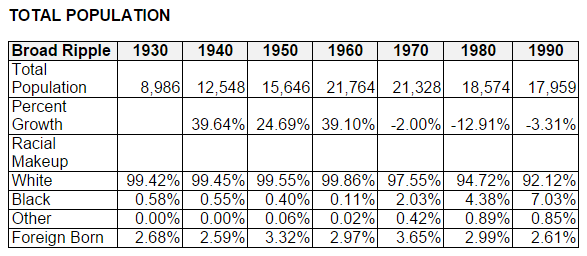
Note: “Other” refers to people whose reported race is Asian, Aleutian, or American Indian. Hispanic origins are not considered a race but an ethnicity, and thus are not reflected in this table.
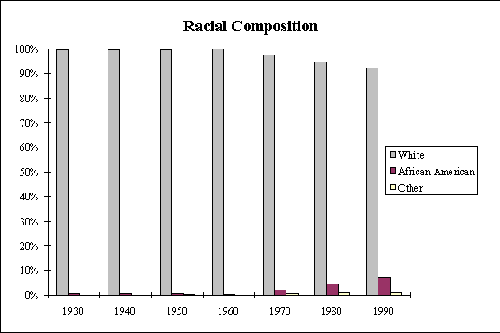
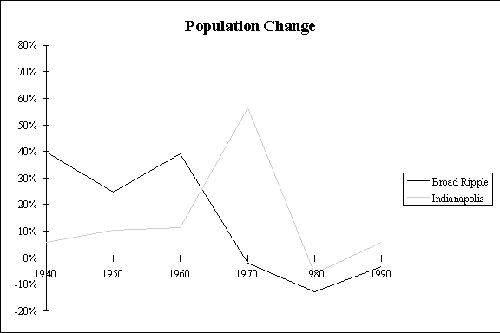
Note: The spike in the population growth for Indianapolis in 1970 represents the expansion of the city boundaries to include most of Marion County under Unigov.

Note: “Youth” is defined as population under 19 years of age, and “Seniors” are defined as those 65 years of age and older.
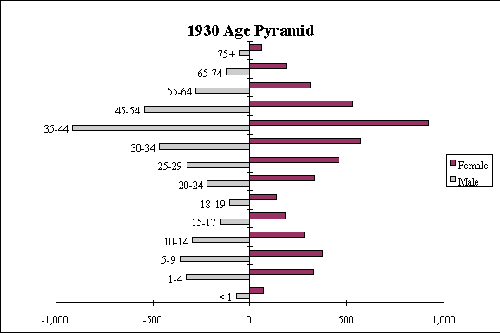

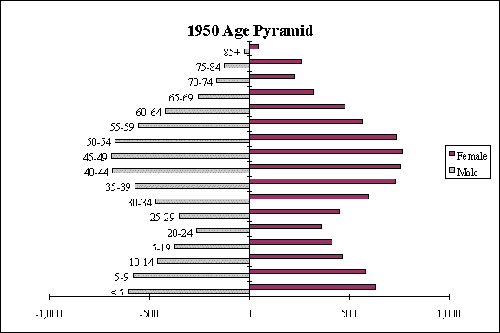

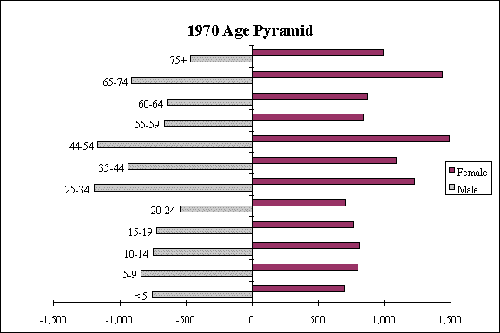
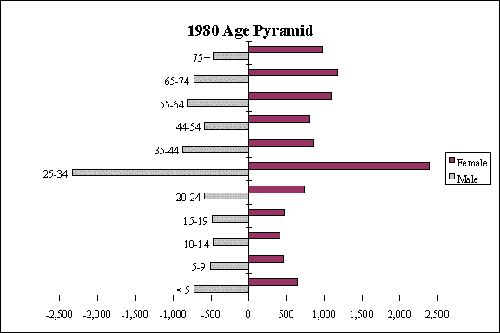
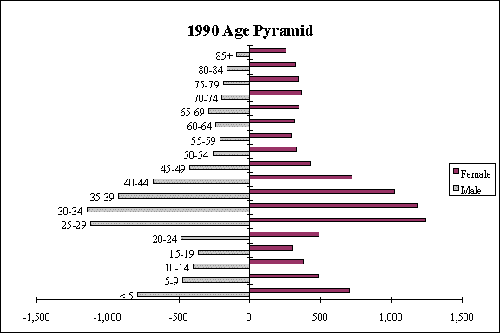
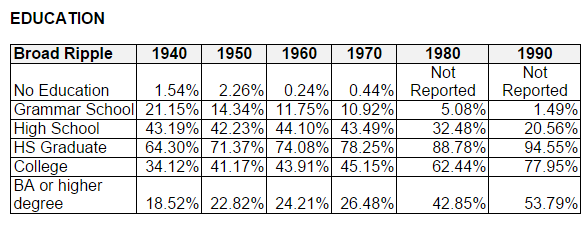
Note: The “No Education” information was not reported for 1980 and 1990.
Note: These numbers represent the highest grade completed of the adult population 25 years and older.
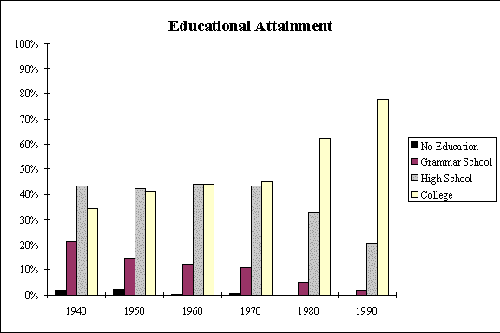
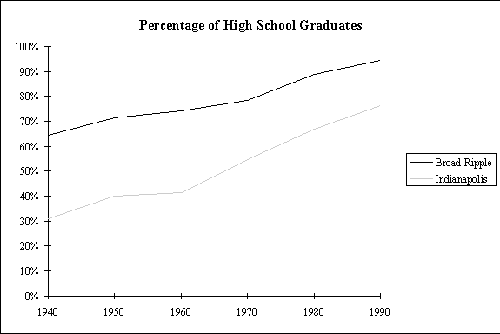

Note: The numbers reflect the status of the population 15 years and older. This question was not asked in 1940.
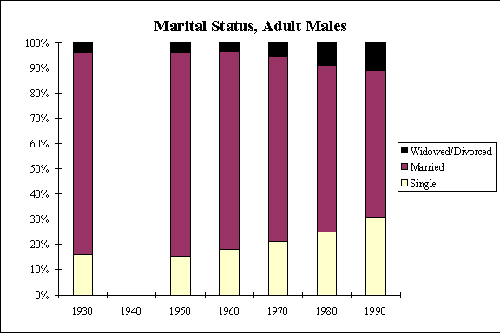
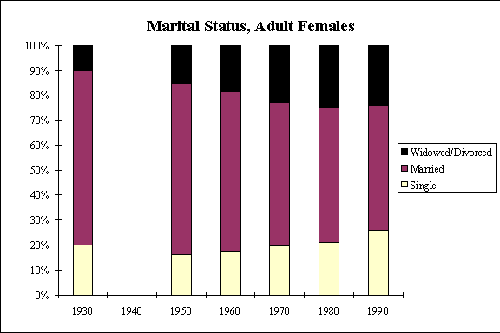
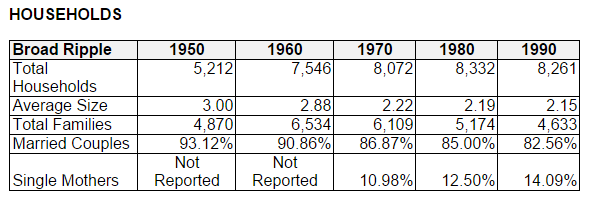
Note: Household is defined as all persons living in a single dwelling while a family includes only nuclear family members.
Note: The information on single mothers was not collected before 1970.
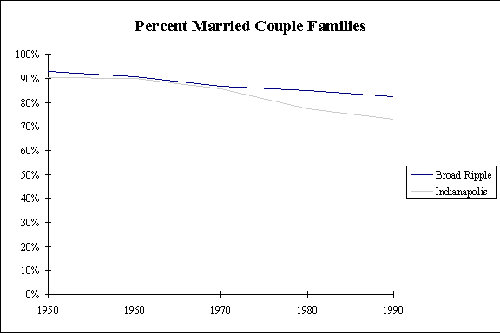
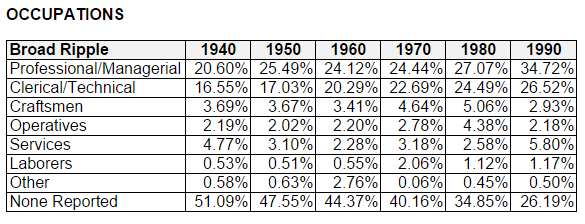
Note: The numbers reflect the status of the adult population 16 years and older.

Note: All incomes are self-reported per household, in contemporary dollar values and do not account for inflation.
Note: Employment figures include only those who were employed at the time of the census, thus the numbers do not necessarily reflect chronic unemployment.
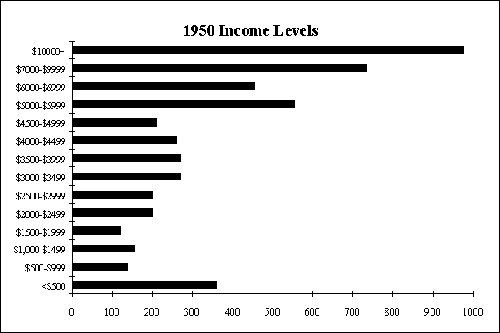
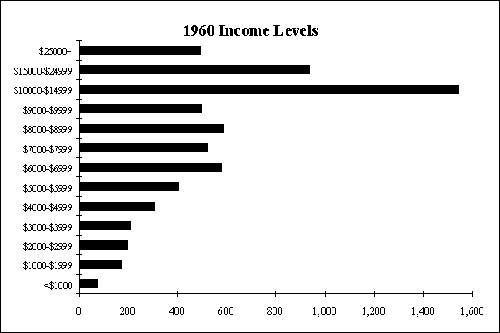
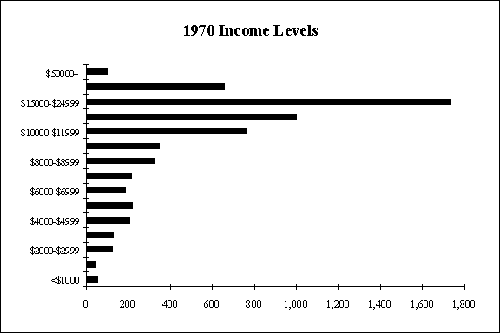
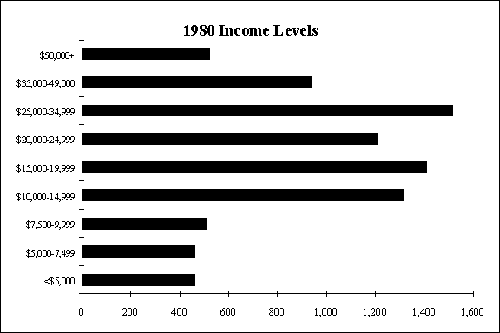
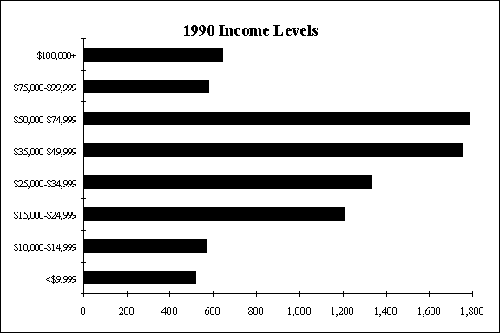
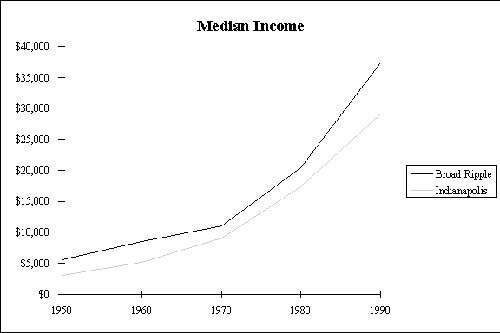
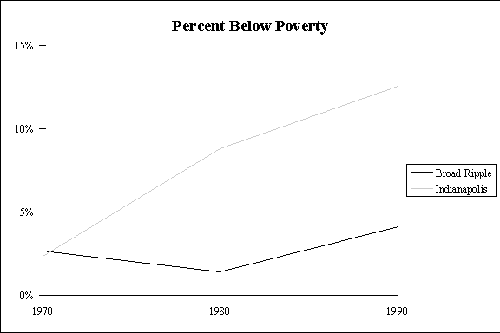
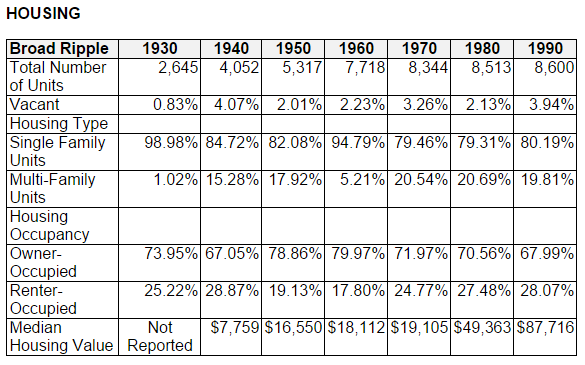
Note: “Median Housing Value” is reported in contemporary dollar values and do not account for inflation.
